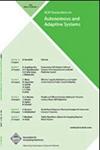Bionic Autonomic Nervous Systems for Self-Defense against DoS, Spyware, Malware, Virus, and Fishing
IF 2.2
4区 计算机科学
Q3 COMPUTER SCIENCE, ARTIFICIAL INTELLIGENCE
引用次数: 6
Abstract
Computing systems and networks become increasingly large and complex with a variety of compromises and vulnerabilities. The network security and privacy are of great concern today, where self-defense against different kinds of attacks in an autonomous and holistic manner is a challenging topic. To address this problem, we developed an innovative technology called Bionic Autonomic Nervous System (BANS). The BANS is analogous to biological nervous system, which consists of basic modules like cyber axon, cyber neuron, peripheral nerve and central nerve. We also presented an innovative self-defense mechanism which utilizes the Fuzzy Logic, Neural Networks, and Entropy Awareness, etc. Equipped with the BANS, computer and network systems can intelligently self-defend against both known and unknown compromises/attacks including denial of services (DoS), spyware, malware, and virus. BANS also enabled multiple computers to collaboratively fight against some distributed intelligent attacks like DDoS. We have implemented the BANS in practice. Some case studies and experimental results exhibited the effectiveness and efficiency of the BANS and the self-defense mechanism.用于防御DoS,间谍软件,恶意软件,病毒和钓鱼的仿生自主神经系统
计算系统和网络变得越来越庞大和复杂,有各种各样的妥协和漏洞。当今,网络安全和隐私问题备受关注,如何以自主和整体的方式防御各种攻击是一个具有挑战性的话题。为了解决这个问题,我们开发了一种名为仿生自主神经系统(BANS)的创新技术。ban类似于生物神经系统,由网络轴突、网络神经元、周围神经和中枢神经等基本模块组成。我们还提出了一种利用模糊逻辑、神经网络和熵感知等创新的自我防御机制。配备ban后,电脑和网络系统可以智能地自我防御已知和未知的危害/攻击,包括拒绝服务(DoS)、间谍软件、恶意软件和病毒。ban还使多台计算机能够协同对抗一些分布式智能攻击,如DDoS。我们已经在实践中实施了ban。一些案例研究和实验结果显示了ban和自卫机制的有效性和效率。
本文章由计算机程序翻译,如有差异,请以英文原文为准。
求助全文
约1分钟内获得全文
求助全文
来源期刊

ACM Transactions on Autonomous and Adaptive Systems
工程技术-计算机:理论方法
CiteScore
4.80
自引率
7.40%
发文量
9
审稿时长
>12 weeks
期刊介绍:
TAAS addresses research on autonomous and adaptive systems being undertaken by an increasingly interdisciplinary research community -- and provides a common platform under which this work can be published and disseminated. TAAS encourages contributions aimed at supporting the understanding, development, and control of such systems and of their behaviors.
TAAS addresses research on autonomous and adaptive systems being undertaken by an increasingly interdisciplinary research community - and provides a common platform under which this work can be published and disseminated. TAAS encourages contributions aimed at supporting the understanding, development, and control of such systems and of their behaviors. Contributions are expected to be based on sound and innovative theoretical models, algorithms, engineering and programming techniques, infrastructures and systems, or technological and application experiences.
 求助内容:
求助内容: 应助结果提醒方式:
应助结果提醒方式:


